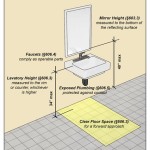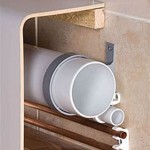How To Get The Screen Out Of A Bathroom Faucet
A clogged aerator screen is a common cause of low water pressure in bathroom faucets. Mineral deposits, debris, and sediment can accumulate in this small filter, restricting water flow. Removing and cleaning the aerator is a simple task that can restore full water pressure and improve faucet performance. This article provides a step-by-step guide to removing and cleaning a bathroom faucet aerator.
Identify the Aerator Type
Bathroom faucet aerators come in various designs. Most are screw-on types, but some are held in place by a hidden set screw or require specialized tools for removal. Before starting, carefully inspect the aerator to determine its specific type. Look for notches around the edge, which indicate a screw-on aerator, or a small set screw, typically located on the side or underside of the faucet body.
For standard screw-on aerators, the removal process is relatively straightforward. However, for aerators with a set screw, a hex wrench will be required. The size of the hex wrench will vary depending on the faucet model. For faucets with unusual aerator designs or those that are difficult to access, consulting the manufacturer's instructions or contacting a plumbing professional is recommended.
Protect the Faucet Finish
Before attempting to remove the aerator, it's crucial to protect the faucet finish from potential scratches. Cover the jaws of pliers or any tool used in the process with masking tape or a soft cloth. This precautionary measure will prevent marring the faucet's surface and maintain its aesthetic appeal. Applying gentle pressure during the removal process will further minimize the risk of damage.
Consider placing a towel or drain stopper in the sink basin to catch any small parts that might be dropped during the process. This prevents loss of small components and simplifies cleanup.
Remove the Aerator
For screw-on aerators, grip the aerator firmly with a covered pair of pliers and turn it counterclockwise. If the aerator is particularly tight, try using a rubber grip pad or strap wrench for added leverage. Avoid applying excessive force, as this could damage the aerator or the faucet. If the aerator resists turning, penetrating oil can be applied to the threads and allowed to sit for a few minutes before attempting removal again.
If the aerator is secured by a set screw, locate the set screw and loosen it using the appropriately sized hex wrench. Once the set screw is loose, the aerator can typically be pulled straight out from the faucet body. In some instances, a slight twisting motion may be necessary to dislodge the aerator.
Cache aerators are often designed to be removed by hand. Gently grasp the outer rim of the cache aerator and pull it downwards. If the aerator is resistant, try twisting it slightly while pulling. Avoid using pliers or other tools, as these may damage the cache assembly.
Clean the Aerator
Once the aerator is removed, disassemble it completely. This usually involves separating the screen, washer, and housing. Rinse all parts under running water to remove loose debris. For stubborn mineral deposits, soak the components in a solution of white vinegar and water for several hours or overnight. A toothbrush or small brush can be used to gently scrub away any remaining buildup. Avoid using abrasive cleaners or harsh chemicals, as these can damage the aerator components.
Inspect the components for any signs of wear or damage. If the screen is torn or the housing is cracked, it's advisable to replace the entire aerator. Replacement aerators are readily available at hardware stores and plumbing supply outlets.
Reassemble and Install the Aerator
After cleaning, reassemble the aerator in the reverse order of disassembly, ensuring all parts are securely fitted. Apply a small amount of plumber's grease to the threads of the aerator before screwing it back onto the faucet. This will help prevent future sticking and facilitate easier removal next time.
Hand-tighten the aerator initially, then use covered pliers to give it a final snug fit. Avoid overtightening, as this could damage the aerator or the faucet threads. Once installed, turn on the water to check for leaks and ensure proper water flow.
If the faucet still exhibits low water pressure after cleaning the aerator, the problem may lie elsewhere in the plumbing system. Further investigation by a qualified plumber may be necessary to identify and resolve the issue.

How To Clean A Sink Faucet Screen

How To Unclog A Faucet Aerator For Dummies

Remove Water Faucet Aerator Delta

How To Clean A Bathroom Sink Faucet Aerator Screen Low Water Pressure

Fixing A Faucet Aerator You Can Be Diy R Too The Kim Six Fix

How To Clean A Faucet Aerator

Public Bathroom Faucet Time Delay Self Closing Water Saving Sink Tap 3 6 Second Flushing Stable Durable Multi Layer Filter Screen Com

Low Flow Faucet Aerator

Wowow Battery Powered Commercial Touchless Single Hole Bathroom Faucet With Deck Plate In Brushed Nickel 2322301 Bhhd The Home Depot

After Cleaning The Faucet Screen I Can Never Remember How Stuff Should Be Reassembled Bathroom Diy S Aerator
Related Posts







